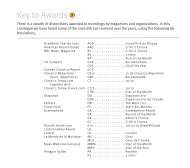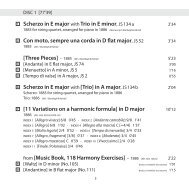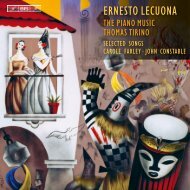MENDELSSOHN - Bis
MENDELSSOHN - Bis
MENDELSSOHN - Bis
You also want an ePaper? Increase the reach of your titles
YUMPU automatically turns print PDFs into web optimized ePapers that Google loves.
set off for Scotland with his friend Karl Klinge mann. Mendels sohn’s Romantic<br />
imagination was often fired by impressions from nature and landscapes, and Scot -<br />
land was the Romantic retreat par excel lence, celebrated in literature as the retreat<br />
of solitary heroes amid the rugged Highland scenery and its melancholy tunes –<br />
in other words, ideal conditions for a musical travelogue. From Edin burgh, on<br />
30th July 1829, he wrote to his parents:<br />
‘In the dusk we went today to the palace where Mary Stuart lived and loved…<br />
The chapel… is now without a roof; grass and ivy are growing there in abund -<br />
ance; and at the ruined altar Mary was crowned Queen of Scotland. Everything<br />
there lies rotten and in ruins; the clear daylight shines right in. I think that today I<br />
found the beginning of my ‘Scottish’ Symphony.’<br />
It was to take some time, however, before he set to work on the sketches: his<br />
great voyage of education of 1830–32, which took him to Italy and elsewhere,<br />
put other ideas into his head. Mendelssohn wrote from Rome in 1831: ‘Spring is<br />
in bloom; outside there is a warm blue sky, and my thoughts are filled with the<br />
journey to Naples… Who can thus blame me for not being able to transport<br />
myself back to the misty moods of Scotland? For this reason I have had to post -<br />
pone the symphony.’<br />
And so he first produced his ‘Italian’ Symphony; the first significant musical<br />
souvenir of the trip to Scot land was to be the Hebrides Overture, Op. 26. The<br />
‘Scottish’ Symphony, on the other hand, was not completed until 1841–42. It<br />
starts with the mournful sounds of a slow introduction (Andante con moto), which<br />
is no doubt a reflection of Mary Stuart’s chapel. The music soon grows more<br />
lively with the Allegro un poco agi tato main theme, and its ‘Scottish’ moods<br />
char acterize both the second sub ject and some appealing subsidiary ideas. After a<br />
dramatic climax the first move ment ends as it had begun: with material from the<br />
lyrical introduction. This cyclical device may have been borrowed from Schu -<br />
27








